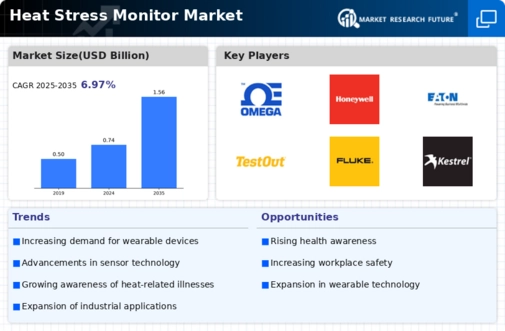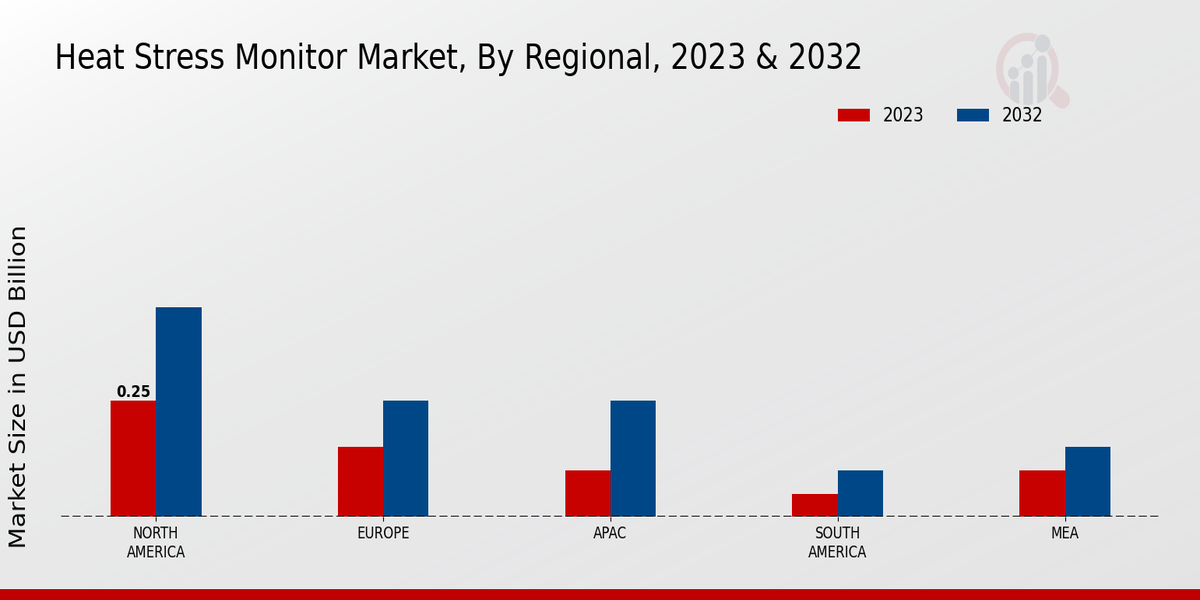Market Growth Projections
The Global Heat Stress Monitor Market Industry is poised for substantial growth over the next decade. Projections indicate that the market will reach 0.74 USD Billion in 2024 and is expected to expand to 1.56 USD Billion by 2035. This growth trajectory reflects a compound annual growth rate (CAGR) of 7.03% from 2025 to 2035. The increasing awareness of heat stress, coupled with advancements in technology and regulatory compliance, is likely to drive this expansion. As organizations across various sectors recognize the importance of monitoring heat stress levels, the demand for innovative solutions is anticipated to rise, further solidifying the market's growth potential.
Rising Temperatures and Climate Change
The impact of rising temperatures and climate change is a significant driver for the Global Heat Stress Monitor Market Industry. As global temperatures continue to increase, the frequency and intensity of heatwaves are expected to rise, leading to heightened risks of heat stress in various sectors. This trend necessitates the implementation of effective monitoring solutions to safeguard individuals working in extreme heat conditions. The market is projected to expand, reaching 1.56 USD Billion by 2035, as organizations recognize the need for proactive measures to address the challenges posed by climate change. The urgency to adapt to these environmental changes is likely to propel the demand for heat stress monitoring technologies.
Regulatory Compliance and Safety Standards
Regulatory compliance and safety standards are increasingly influencing the Global Heat Stress Monitor Market Industry. Governments and regulatory bodies are establishing stringent guidelines to protect workers from heat-related hazards, particularly in industries such as construction and agriculture. Compliance with these regulations necessitates the adoption of heat stress monitoring systems to ensure worker safety and avoid potential legal repercussions. For instance, the Occupational Safety and Health Administration (OSHA) has emphasized the need for heat stress management protocols. This regulatory push is likely to drive market growth, as organizations seek to align with safety standards and protect their workforce.
Increasing Awareness of Heat-Related Illnesses
The rising awareness of heat-related illnesses is a crucial driver for the Global Heat Stress Monitor Market Industry. As temperatures continue to rise globally, the incidence of heat stress and related health issues has become more pronounced. This has led to increased demand for monitoring solutions that can help prevent heat-related illnesses in various sectors, including agriculture, construction, and sports. For instance, organizations are now implementing heat stress monitoring systems to ensure worker safety, which is vital in high-temperature environments. The market is projected to reach 0.74 USD Billion in 2024, reflecting a growing recognition of the importance of heat stress management.
Technological Advancements in Monitoring Devices
Technological advancements play a pivotal role in driving the Global Heat Stress Monitor Market Industry. Innovations in sensor technology, data analytics, and wearable devices have enhanced the accuracy and efficiency of heat stress monitoring solutions. For example, the integration of real-time data analytics allows for immediate feedback on environmental conditions, enabling proactive measures to mitigate heat stress. Furthermore, the development of user-friendly applications has made it easier for organizations to implement these technologies. As a result, the market is expected to grow significantly, with a projected CAGR of 7.03% from 2025 to 2035, indicating a robust future for heat stress monitoring solutions.
Growing Adoption in Sports and Fitness Industries
The growing adoption of heat stress monitoring solutions in the sports and fitness industries is a notable driver for the Global Heat Stress Monitor Market Industry. Athletes and fitness enthusiasts are increasingly aware of the risks associated with exercising in high temperatures, leading to a demand for monitoring devices that can track heat stress levels. Sports organizations are implementing these technologies to ensure athlete safety and optimize performance. For example, professional sports teams are utilizing heat stress monitors during training sessions to prevent heat-related illnesses. This trend is expected to contribute to market growth, as the emphasis on health and safety in sports continues to rise.






















